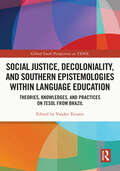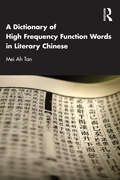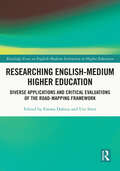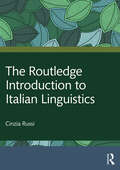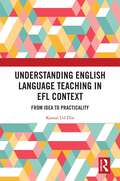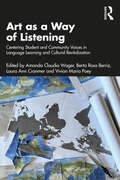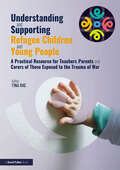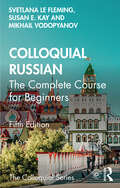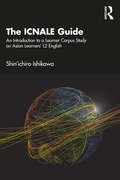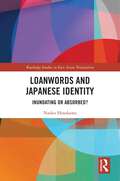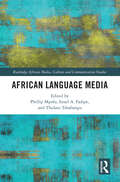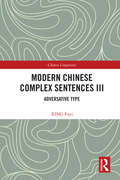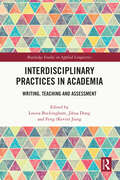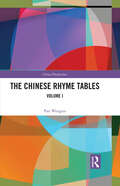- Table View
- List View
Social Justice, Decoloniality, and Southern Epistemologies within Language Education: Theories, Knowledges, and Practices on TESOL from Brazil (Global South Perspectives on TESOL)
by Vander TavaresWith a strong focus on decoloniality and social justice, this volume brings together critical theories, concepts, and practices on TESOL from multiple Brazilian perspectives. The chapters showcase the work of teachers and teacher educators in confronting sociopolitical issues in Brazil, including in the domains of democracy, language education, and knowledge production, as well as prevailing issues within TESOL itself. Contributions stem from an eclectic range of analytical orientations that reflect ontological and epistemological diversity while demonstrating why, where, and how TESOL is done in Brazil. In doing so, this volume also establishes a place for Southern voices to be heard in the move toward challenging complex and long-standing issues of representation, marginalization, and exclusion that have traditionally characterised North-South relations in TESOL as a field. This volume seeks to promote Southern-based conversations about decoloniality and social justice in TESOL and will be of direct relevance to graduate students, researchers, and scholars in the field of TESOL and foreign language education.
Social Justice, Decoloniality, and Southern Epistemologies within Language Education: Theories, Knowledges, and Practices on TESOL from Brazil (Global South Perspectives on TESOL)
by Vander TavaresWith a strong focus on decoloniality and social justice, this volume brings together critical theories, concepts, and practices on TESOL from multiple Brazilian perspectives. The chapters showcase the work of teachers and teacher educators in confronting sociopolitical issues in Brazil, including in the domains of democracy, language education, and knowledge production, as well as prevailing issues within TESOL itself. Contributions stem from an eclectic range of analytical orientations that reflect ontological and epistemological diversity while demonstrating why, where, and how TESOL is done in Brazil. In doing so, this volume also establishes a place for Southern voices to be heard in the move toward challenging complex and long-standing issues of representation, marginalization, and exclusion that have traditionally characterised North-South relations in TESOL as a field. This volume seeks to promote Southern-based conversations about decoloniality and social justice in TESOL and will be of direct relevance to graduate students, researchers, and scholars in the field of TESOL and foreign language education.
A Dictionary of High Frequency Function Words in Literary Chinese
by Mei Ah TanA Dictionary of High Frequency Function Words in Literary Chinese is the first comprehensive work on the subject that constitutes a new approach to teaching and learning by providing both a reference tool and a reader. This dictionary can serve both as a reference book and as an anthology for teaching and learning literary Chinese (the premodern written language) and both ancient and contemporary Chinese culture. It differs from the traditional design of dictionaries in that it includes detailed explanations, with examples, for different uses of the graphs most often used to represent function words in literary Chinese. To facilitate teaching and learning through association, the early meaning, extended meanings, and borrowed meanings for each graph are provided, along with explanations supported by the various stages of the historical development of the graph and other relevant research. Each word is grouped into the primary word class to which it belongs, based on its lexical or grammatical meanings, its collocations, and its function in a sentence. Modern idioms derived from words and phrases in the sample passages are provided in order to promote cultural knowledge and show the important role literary Chinese continues to play in everyday life. All Chinese words are provided with Putonghua romanization to facilitate learning and recall through sound; special pronunciations are explained. This book can be used as a textbook, as extended reading, or as a reference work for undergraduate or graduate classes on literary/classical Chinese, Chinese manuscript studies, Chinese language and culture, Putonghua, translation studies, or even linguistics. It can also be used as an anthology from which the teacher can select passages for students to study.
Researching English-Medium Higher Education: Diverse Applications and Critical Evaluations of the ROAD-MAPPING Framework (Routledge Focus on English-Medium Instruction in Higher Education)
by Emma Dafouz Ute SmitSet against the increasing use of English-medium higher education across the world, this book brings together researchers and practitioners who, despite coming from very different geopolitical areas and pursuing distinct research objectives, coincide in their use of the ROAD-MAPPING conceptual framework. With the use of this framework and its six interrelated dimensions, the nine studies included in this volume explore key topics for English-Medium Education in Multilingual University Settings (EMEMUS) from diverse perspectives. These range from multi-sited, meta-level approaches critically analysing different countries and their realisations of EMEMUS to using ROAD-MAPPING as a methodological tool to analyse all its dimensions or place the lens on a particular aspect. By doing so, the contributions demonstrate the strength of the ROAD-MAPPING framework for investigating and understanding the complex nature of EMEMUS. The volume makes a valuable contribution to the development of EMEMUS research and is thus highly recommended for scholars, policymakers and students interested in one of the most fast-growing (and contested) research areas in applied linguistics today.
Researching English-Medium Higher Education: Diverse Applications and Critical Evaluations of the ROAD-MAPPING Framework (Routledge Focus on English-Medium Instruction in Higher Education)
by Ute SmitSet against the increasing use of English-medium higher education across the world, this book brings together researchers and practitioners who, despite coming from very different geopolitical areas and pursuing distinct research objectives, coincide in their use of the ROAD-MAPPING conceptual framework. With the use of this framework and its six interrelated dimensions, the nine studies included in this volume explore key topics for English-Medium Education in Multilingual University Settings (EMEMUS) from diverse perspectives. These range from multi-sited, meta-level approaches critically analysing different countries and their realisations of EMEMUS to using ROAD-MAPPING as a methodological tool to analyse all its dimensions or place the lens on a particular aspect. By doing so, the contributions demonstrate the strength of the ROAD-MAPPING framework for investigating and understanding the complex nature of EMEMUS. The volume makes a valuable contribution to the development of EMEMUS research and is thus highly recommended for scholars, policymakers and students interested in one of the most fast-growing (and contested) research areas in applied linguistics today.
The Routledge Introduction to Italian Linguistics
by Cinzia RussiThe Routledge Introduction to Italian Linguistics offers a systematic and comprehensive overview of the linguistic structure of the Italian language, including phonetics and phonology, morphology and morphosyntax, syntax, semantics, and sociolinguistics. The manual includes a historical sketch of the Italian language, which outlines the central phases of its emergence and process of standardization. Written in clear, concise language and taking a descriptive, theory-neutral approach, this is the ideal companion for advanced students of the Italian language and those studying Italian and Romance linguistics. After sketching the most important phases of the process of standardization of Italian and introducing the main varieties of Italian as classified from a social and geographical perspective, this introductory text addresses the core topics of Italian linguistics as pertaining to the sound system and word and sentence structure. The text adopts a descriptive approach and requires no previous knowledge of linguistics since technical terms are carefully explained and illustrated by numerous examples. Thus, it can serve as a reference tool for instructors of Italian and anyone interested in advancing their knowledge of the Italian language or familiarizing themselves with Italian linguistics.
The Routledge Introduction to Italian Linguistics
by Cinzia RussiThe Routledge Introduction to Italian Linguistics offers a systematic and comprehensive overview of the linguistic structure of the Italian language, including phonetics and phonology, morphology and morphosyntax, syntax, semantics, and sociolinguistics. The manual includes a historical sketch of the Italian language, which outlines the central phases of its emergence and process of standardization. Written in clear, concise language and taking a descriptive, theory-neutral approach, this is the ideal companion for advanced students of the Italian language and those studying Italian and Romance linguistics. After sketching the most important phases of the process of standardization of Italian and introducing the main varieties of Italian as classified from a social and geographical perspective, this introductory text addresses the core topics of Italian linguistics as pertaining to the sound system and word and sentence structure. The text adopts a descriptive approach and requires no previous knowledge of linguistics since technical terms are carefully explained and illustrated by numerous examples. Thus, it can serve as a reference tool for instructors of Italian and anyone interested in advancing their knowledge of the Italian language or familiarizing themselves with Italian linguistics.
Understanding English Language Teaching in EFL Context: From Idea to Practicality
by Kamal Ud DinThis volume is comprehensively designed to help prospective English Language Teaching (EFL) teachers specializing in EFL mainly in South Asian countries. It analyses the application of ELT theories, concepts, and methods to sharpen their understanding of the various techniques used for teaching English effectively in the EFL context. The book discusses the basic concepts of language aimed to develop a sense of the language phenomenon as a unique human attribute. It covers the theories of language from various disciplines such as biology, sociology, psychology, and linguistics. The book explains the underlying structures or components that shape the edifice of languages such as phonology, morphology, syntax, grammar, phonetics, semantics, and pragmatics. While taking the reader through language learning theories with a focus on English as the second language, it discusses the different teaching methods that can be adopted by teachers in classroom settings. The book will be of interest to teachers, students and researchers of education, teacher education, and English Language Teaching. It will also be useful for educators, English language teachers, language learners, professionals working in the field of education and language, and those who aspire to teach and learn English in Foreign context.
Understanding English Language Teaching in EFL Context: From Idea to Practicality
by Kamal Ud DinThis volume is comprehensively designed to help prospective English Language Teaching (EFL) teachers specializing in EFL mainly in South Asian countries. It analyses the application of ELT theories, concepts, and methods to sharpen their understanding of the various techniques used for teaching English effectively in the EFL context. The book discusses the basic concepts of language aimed to develop a sense of the language phenomenon as a unique human attribute. It covers the theories of language from various disciplines such as biology, sociology, psychology, and linguistics. The book explains the underlying structures or components that shape the edifice of languages such as phonology, morphology, syntax, grammar, phonetics, semantics, and pragmatics. While taking the reader through language learning theories with a focus on English as the second language, it discusses the different teaching methods that can be adopted by teachers in classroom settings. The book will be of interest to teachers, students and researchers of education, teacher education, and English Language Teaching. It will also be useful for educators, English language teachers, language learners, professionals working in the field of education and language, and those who aspire to teach and learn English in Foreign context.
Art as a Way of Listening: Centering Student and Community Voices in Language Learning and Cultural Revitalization
by Amanda Claudia Wager Berta Rosa Berriz Laura Ann Cranmer Vivian Maria PoeyOffering a wealth of art-based practices, this volume invites readers to reimagine the joyful possibility and power of language and culture in language and literacy learning. Understanding art as a tool that can be used for decolonizing minds, the contributors explore new methods and strategies for supporting the language and literacy learning skills of multilingual students. Contributors are artists, educators, and researchers who bring together cutting-edge theory and practice to present a broad range of traditional and innovative art forms and media that spotlight the roles of artful resistance and multilingual activism. Featuring questions for reflection and curricular applications, chapters address theoretical issues and pedagogical strategies related to arts and language learning, including narrative inquiry, journaling, social media, oral storytelling, and advocacy projects. The innovative methods and strategies in this book demonstrate how arts-based, decolonizing practices are essential in fostering inclusive educational environments and supporting multilingual students’ cultural and linguistic repertoires. Transformative and engaging, this text is a key resource for educators, scholars, and researchers in literacy and language education.
Art as a Way of Listening: Centering Student and Community Voices in Language Learning and Cultural Revitalization
by Amanda Claudia Wager Berta Rosa Berriz Laura Ann Cranmer Vivian Maria PoeyOffering a wealth of art-based practices, this volume invites readers to reimagine the joyful possibility and power of language and culture in language and literacy learning. Understanding art as a tool that can be used for decolonizing minds, the contributors explore new methods and strategies for supporting the language and literacy learning skills of multilingual students. Contributors are artists, educators, and researchers who bring together cutting-edge theory and practice to present a broad range of traditional and innovative art forms and media that spotlight the roles of artful resistance and multilingual activism. Featuring questions for reflection and curricular applications, chapters address theoretical issues and pedagogical strategies related to arts and language learning, including narrative inquiry, journaling, social media, oral storytelling, and advocacy projects. The innovative methods and strategies in this book demonstrate how arts-based, decolonizing practices are essential in fostering inclusive educational environments and supporting multilingual students’ cultural and linguistic repertoires. Transformative and engaging, this text is a key resource for educators, scholars, and researchers in literacy and language education.
Understanding and Supporting Refugee Children and Young People: A Practical Resource for Teachers, Parents and Carers of Those Exposed to the Trauma of War
by Tina RaeThis book is the go-to resource for those parents and professionals seeking to support children through the trauma of war and conflict. Not only does it provide the evidence base for effectively integrating refugee children into their new schools, but it also introduces the reader to a range of key tools and strategies to both understand and manage anxiety and trauma -related behaviours. Practical and user-friendly, it demystifies the process of talking about difficult topics, providing helpful advice on how to do this in a trauma informed way, making use of effective tools from therapeutic approaches to help our children and ourselves remain regulated and able to engage in post-traumatic growth.
Colloquial Russian: The Complete Course For Beginners
by Svetlana le Fleming Susan E. Kay Mikhail VodopyanovColloquial Russian provides a step-by-step course in Russian as it is written and spoken today. Combining a user-friendly approach with a thorough treatment of the language, it equips learners with the essential skills needed to communicate confidently and effectively in Russian in a broad range of situations, requiring no prior knowledge of the language. Features include: progressive coverage of speaking, listening, reading and writing skills structured, jargon-free explanations of grammar an extensive range of focused and stimulating exercises realistic and entertaining dialogues covering a broad variety of scenarios useful vocabulary lists throughout the text additional resources available at the back of the book, including a full answer key, a grammar summary and bilingual glossaries This fifth edition offers modernised language reflecting social and cultural changes, new vocabulary that's essential for day-to-day interactions, and updated audio material. Balanced, comprehensive and rewarding, Colloquial Russian will be an indispensable resource for both independent learners and students taking courses in Russian. Audio material to accompany the course is available to download for free in MP3 format from www.routledge.com/cw/colloquials. The audio material features the texts, dialogues and exercises from the book and will help develop listening and pronunciation skills.
Colloquial Russian: The Complete Course For Beginners
by Svetlana le Fleming Susan E. Kay Mikhail VodopyanovColloquial Russian provides a step-by-step course in Russian as it is written and spoken today. Combining a user-friendly approach with a thorough treatment of the language, it equips learners with the essential skills needed to communicate confidently and effectively in Russian in a broad range of situations, requiring no prior knowledge of the language. Features include: progressive coverage of speaking, listening, reading and writing skills structured, jargon-free explanations of grammar an extensive range of focused and stimulating exercises realistic and entertaining dialogues covering a broad variety of scenarios useful vocabulary lists throughout the text additional resources available at the back of the book, including a full answer key, a grammar summary and bilingual glossaries This fifth edition offers modernised language reflecting social and cultural changes, new vocabulary that's essential for day-to-day interactions, and updated audio material. Balanced, comprehensive and rewarding, Colloquial Russian will be an indispensable resource for both independent learners and students taking courses in Russian. Audio material to accompany the course is available to download for free in MP3 format from www.routledge.com/cw/colloquials. The audio material features the texts, dialogues and exercises from the book and will help develop listening and pronunciation skills.
The ICNALE Guide: An Introduction to a Learner Corpus Study on Asian Learners’ L2 English
by Shin'ichiro IshikawaThis book provides a practical and extensive guide for the International Corpus Network of Asian Learners of English (ICNALE), a unique dataset including more than 15,000 samples of Asian learners’ L2 English speeches and essays. It also offers approachable introductions to a variety of corpus studies on the aspects of Asian learners’ L2 English. Key topics discussed in the book include: • background, aims, and methods of learner corpus research, • principles, designs, and applications of the ICNALE, • vocabulary, grammar, and pragmatics in Asian learners’ L2 English, and • individual differences of Asian learners and assessments of their speeches and essays. With many case studies and hands-on guides to utilise ICNALE data to the fullest extent, The ICNALE Guide is a unique resource for students, teachers, and researchers who are interested in a corpus-based analysis of L2 acquisition.
The ICNALE Guide: An Introduction to a Learner Corpus Study on Asian Learners’ L2 English
by Shin'ichiro IshikawaThis book provides a practical and extensive guide for the International Corpus Network of Asian Learners of English (ICNALE), a unique dataset including more than 15,000 samples of Asian learners’ L2 English speeches and essays. It also offers approachable introductions to a variety of corpus studies on the aspects of Asian learners’ L2 English. Key topics discussed in the book include: • background, aims, and methods of learner corpus research, • principles, designs, and applications of the ICNALE, • vocabulary, grammar, and pragmatics in Asian learners’ L2 English, and • individual differences of Asian learners and assessments of their speeches and essays. With many case studies and hands-on guides to utilise ICNALE data to the fullest extent, The ICNALE Guide is a unique resource for students, teachers, and researchers who are interested in a corpus-based analysis of L2 acquisition.
Loanwords and Japanese Identity: Inundating or Absorbed? (Routledge Studies In East Asian Translation Ser.)
by Naoko HosokawaLoanwords and Japanese Identity: Inundating or Absorbed? provides an in-depth examination of public discussions on lexical borrowing in the Japanese language. The main objective of this book is to explore the relationship between language and identity through an analysis of public attitudes towards foreign loanwords in contemporary Japanese society. In particular, the book uncovers the process by which language is conceived of as a symbol of national identity by examining an animated newspaper controversy over the use of foreign loanwords. The book concludes that the fierce debate over the use of loanwords can be understood as a particular manifestation of the ongoing (re-)negotiation of Japanese national identity. This book will appeal to scholars and students in sociolinguistics, translation studies, and discourse analysis, while its cultural and geographic focus will attract readers in Japanese studies and East Asian studies.
Loanwords and Japanese Identity: Inundating or Absorbed? (Routledge Studies In East Asian Translation Ser.)
by Naoko HosokawaLoanwords and Japanese Identity: Inundating or Absorbed? provides an in-depth examination of public discussions on lexical borrowing in the Japanese language. The main objective of this book is to explore the relationship between language and identity through an analysis of public attitudes towards foreign loanwords in contemporary Japanese society. In particular, the book uncovers the process by which language is conceived of as a symbol of national identity by examining an animated newspaper controversy over the use of foreign loanwords. The book concludes that the fierce debate over the use of loanwords can be understood as a particular manifestation of the ongoing (re-)negotiation of Japanese national identity. This book will appeal to scholars and students in sociolinguistics, translation studies, and discourse analysis, while its cultural and geographic focus will attract readers in Japanese studies and East Asian studies.
African Language Media (Routledge African Media, Culture and Communication Studies)
by Phillip Mpofu Israel A. Fadipe Thulani TshabanguThis book outlines how African language media is affected by politics, technology, culture, and the economy and how this media is creatively produced and appropriated by audiences across cultures and contexts. African language media can be considered as a tool for communication, socialization, and community that defines the various identities of indigenous people in Africa. This book shows how vernacular media outlets including radio and television, as well as native formats such as festivals, rituals and dance, can be used to influence all facets of local peoples’ experience and understanding of community. The book also explores the relationship between African language media sources and contemporary issues including the digitalization conundrum, peace and conflict resolution, identity formation, hate speech and fake news. Furthermore, it shows how local media can be used for development communication purposes during health and environmental crises. The book includes cases studies demonstrating the uses, experiences and activities related to various forms of media available in African languages. This book will be of interest to scholars in the field of communication and media studies, health and environmental communication, journalism, African studies and anthropology.
African Language Media (Routledge African Media, Culture and Communication Studies)
by Phillip Mpofu, Israel A. Fadipe, and Thulani TshabanguThis book outlines how African language media is affected by politics, technology, culture, and the economy and how this media is creatively produced and appropriated by audiences across cultures and contexts. African language media can be considered as a tool for communication, socialization, and community that defines the various identities of indigenous people in Africa. This book shows how vernacular media outlets including radio and television, as well as native formats such as festivals, rituals and dance, can be used to influence all facets of local peoples’ experience and understanding of community. The book also explores the relationship between African language media sources and contemporary issues including the digitalization conundrum, peace and conflict resolution, identity formation, hate speech and fake news. Furthermore, it shows how local media can be used for development communication purposes during health and environmental crises. The book includes cases studies demonstrating the uses, experiences and activities related to various forms of media available in African languages. This book will be of interest to scholars in the field of communication and media studies, health and environmental communication, journalism, African studies and anthropology.
Modern Chinese Complex Sentences III: Adversative Type (Chinese Linguistics)
by XING FuyiThis book is the third volume of a four-volume set on modern Chinese complex sentences, with a focus on adversative complex sentences and relevant forms.Complex sentences in modern Chinese are unique in formation and meaning. The author proposes a tripartite classification of Chinese complex sentences according to the semantic relationships between the clauses, i.e., coordinate, causal, and adversative. This volume analyzes representative forms of adversative type, including the prototype, the clauses linked by connectives referring to otherwise, the combinations of clause structures and certain adversative conjunctions or linking adverbs indicating an adversative relationship, the adversative factors and relationship in two typical progressive structures, factive sentences and concessive forms. It also discusses the adversative type in the broad sense, classifying the different forms and also analyzing the semantic meaning, pragmatic value, and implications for research and language teaching.The book will be a useful reference for scholars and learners of the Chinese language interested in Chinese grammar and language information processing.
Modern Chinese Complex Sentences III: Adversative Type (Chinese Linguistics)
by XING FuyiThis book is the third volume of a four-volume set on modern Chinese complex sentences, with a focus on adversative complex sentences and relevant forms.Complex sentences in modern Chinese are unique in formation and meaning. The author proposes a tripartite classification of Chinese complex sentences according to the semantic relationships between the clauses, i.e., coordinate, causal, and adversative. This volume analyzes representative forms of adversative type, including the prototype, the clauses linked by connectives referring to otherwise, the combinations of clause structures and certain adversative conjunctions or linking adverbs indicating an adversative relationship, the adversative factors and relationship in two typical progressive structures, factive sentences and concessive forms. It also discusses the adversative type in the broad sense, classifying the different forms and also analyzing the semantic meaning, pragmatic value, and implications for research and language teaching.The book will be a useful reference for scholars and learners of the Chinese language interested in Chinese grammar and language information processing.
Interdisciplinary Practices in Academia: Writing, Teaching and Assessment (Routledge Studies in Applied Linguistics)
This volume addresses the implications that academic interdisciplinarity in the field of English for Academic Purposes (EAP) and English for Specific Purposes (ESP) has for research and pedagogy with a global reach. The Editors present a coherent, research-supported analysis of the influence of interdisciplinary research and methods on the way academics collaborate on courses, develop their careers, and teach students. The hitherto prevalence of disciplinary silo-like approaches to academic and scientific issues is increasingly ceding ground to an interdisciplinary synergy of different methodological and epistemological traditions. In the context of ongoing trends towards interdisciplinarity in degree programmes and the increasing popularity of such degree programmes with students (e.g., bioinformatics, computational linguistics, psycholinguistics, neuropolitics, evolutionary finance, global studies, and security studies), academics and programme administrators need awareness of the skills needed to operate in interdisciplinary contexts. Studies in this edited volume examine interdisciplinary communication practices, and identify how academic writing, teaching, language proficiency assessment and degree programmes are responding to changes in the broader social, institutional and political contexts of academia. As authors in the volume demonstrate, the discursive features, literacy practices and instructional modes, and the student experience of these emerging interdisciplines deserve systematic exploration. This insightful volume sheds light on contexts across the globe and will be used by students studying EAP and ESP pedagogy or practice; academics in the fields of applied linguistics and higher education, as well as higher education faculty and administrators interested in interdisciplinarity in degree programmes.
Interdisciplinary Practices in Academia: Writing, Teaching and Assessment (Routledge Studies in Applied Linguistics)
by Louisa Buckingham Jihua Dong Feng Kevin JiangThis volume addresses the implications that academic interdisciplinarity in the field of English for Academic Purposes (EAP) and English for Specific Purposes (ESP) has for research and pedagogy with a global reach. The Editors present a coherent, research-supported analysis of the influence of interdisciplinary research and methods on the way academics collaborate on courses, develop their careers, and teach students. The hitherto prevalence of disciplinary silo-like approaches to academic and scientific issues is increasingly ceding ground to an interdisciplinary synergy of different methodological and epistemological traditions. In the context of ongoing trends towards interdisciplinarity in degree programmes and the increasing popularity of such degree programmes with students (e.g., bioinformatics, computational linguistics, psycholinguistics, neuropolitics, evolutionary finance, global studies, and security studies), academics and programme administrators need awareness of the skills needed to operate in interdisciplinary contexts. Studies in this edited volume examine interdisciplinary communication practices, and identify how academic writing, teaching, language proficiency assessment and degree programmes are responding to changes in the broader social, institutional and political contexts of academia. As authors in the volume demonstrate, the discursive features, literacy practices and instructional modes, and the student experience of these emerging interdisciplines deserve systematic exploration. This insightful volume sheds light on contexts across the globe and will be used by students studying EAP and ESP pedagogy or practice; academics in the fields of applied linguistics and higher education, as well as higher education faculty and administrators interested in interdisciplinarity in degree programmes.
The Chinese Rhyme Tables: Volume I (China Perspectives)
by Pan WenguoAs the first volume of a two-volume set that studies Chinese rhyme tables, this book focuses on their emergence, development, structure, and patterns. Rhyme tables are tabulated tool constituted by phonological properties, which helps indicate the pronunciation of sinograms or Chinese characters, marking a precise and systematic account of the Chinese phonological system. This volume first discusses the emergence of the model and factors that determined its formation and evolution, including the Chinese tradition of the rhyme dictionary and the introduction of Buddhist scripts. The second part analyzes the structure and arrangement patterns of rhyme tables in detail, giving insights into the nature of “division” (deng): the classification and differentiation of speech sounds, of vital significance in the reconstruction of middle Chinese. The author argues that deng has nothing to do with vowel aperture or other phonetic features but is a natural result of rhyme table arrangement. He also reexamines the principles for irregular cases (menfa rules) and categorizes the 20 rules into three types.The book will appeal to scholars and student studying linguistics, Chinese phonology, and Sinology.
